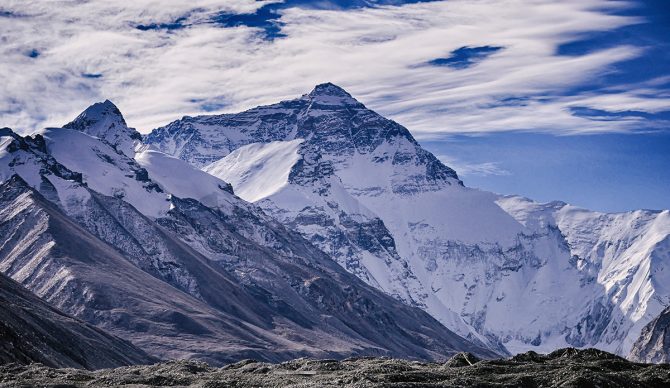
Everest from the Tibetan side. Photo: Ben Gao//Unsplash
The snowpack near the highest peak on the planet is several times deeper than previously thought, according to recent findings from a group of Chinese scientists. They say this revelation could shape a new understanding of the rate of climate change on Earth.
Previous estimates for the snowpack at the summit of Mount Everest ranged from less than a meter (.92 meters) to around 3.5 meters. The methods for figuring this out have been pretty basic over the years. For example, a research team in 1975 took a wooden steak and plunged it into the snow, establishing the .92 meter baseline. In 1992, another research team did the same exact thing with a steel rod and estimated a thickness of 2.52 meters. Then, in 2005, a third research team used ground-penetrating radar to estimate a depth in the ballpark of ~3.5 meters. A similar project was attempted just a few years ago using various radar-based instruments, but no results or estimates were ever reported from that expedition.
For this most recent expedition, the group of Chinese researchers used a single transmitter-receiver antenna at a frequency of 1,000 MHz, measuring from elevation with exposed limestone all the way up to the summit. Their data now tells us that the depth of Everest’s snowpack is actually 9.5 meters deep, plus or minus 1.2 meters. This number comes from the average readings of 26 measuring points at the summit. That’s nine to 10 times more snow than what scientists believed a little over 45 years ago and still close to three times more snow than we’ve been aware in this century.
“This discovery not only reveals the depth of the snow on the summit of Mount Everest but also contributes to a deeper understanding of climate change at extremely high altitudes, opening up new directions for the research,” said Yao Tandong, the leader of the team and the honorary director of the Institute of Tibetan Plateau Research (ITP), CAS.
Now scientists will likely be able to use this new measurement of Everest’s snowpack as a baseline for monitoring climate change, giving us a better understanding of its pace and rate of change at the highest peak on Earth.

